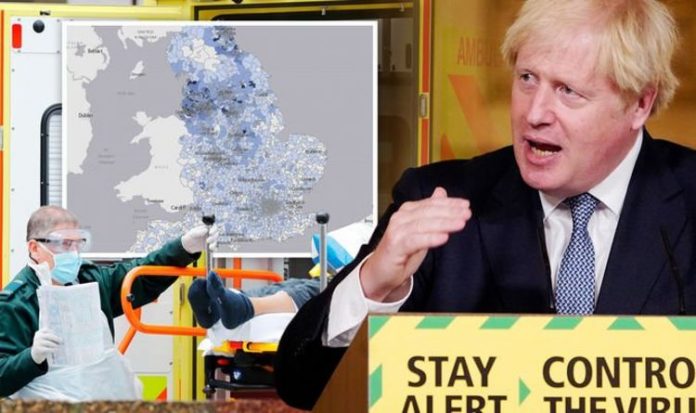England’s deputy chief medical officer Professor Jonathan Van-Tam gave a press conference this morning on the current data surrounding the coronavirus pandemic in the country. Flanked by the medical director of NHS England Professor Stephen Powis and medical lead in Greater Manchester Dr Jane Eddleston, the expert showed a series of maps and charts detailing the second wave of COVID-19 across Britain.
The data showed the number of cases, hospitalisations, deaths and the rate of increase across England in recent days.
This came before Prime Minister Boris Johnson is due to give a press conference on the latest Government restrictions.
A wealth of stricter rules known as a three-tier system are due to come into effect in the coming days.
Mr Johnson will confirm this at 3.30pm in a speech to the House of Commons, before addressing the nation at around 6pm tonight.
Read More: Nightingale hospitals: Which hospitals are preparing for second wave?
In terms of cases, there are 63 Upper Tier Authority (UTA) areas with cases of coronavirus above 1,000 per 100,000 of the population.
Of these, nine areas have seen cases soar to more than 2,000 per 100,000 of the population.
Top of the list is Knowsley, with 2,450.6 cases per 100,000, followed by Oldham with 2,355 cases per 100,000.
The third is Blackburn with Darwen with 2,318 cases per 100,000 and fourth is Manchester with 2,283.6 cases per 100,000 of the population.
Fifth is Liverpool with 2,253.6 cases per 100,000, following confirmation from the city’s leaders that the Army is being brought in to provide “logistics and capacity support” as a tier-three lockdown looms.
Area and rate per 100,000 population
1. Knowsley – 2,450.6
2. Oldham – 2,355
3. Blackburn with Darwen – 2,318
4. Manchester – 2,283.6
5. Liverpool – 2,253.6
6. Leicester – 2,242.1
7. Bradford – 2,162.6
8. Bolton – 2,151.3
9. Rochdale – 2,129.8
10. Newcastle upon Tyne – 1,972.1
11. Bury – 1,946.2
12. St. Helens – 1,860.1
13. Merthyr Tydfil – 1,840
14. Tameside – 1,802.3
15. Salford – 1,788
16. Halton – 1,737.1
17. Sheffield – 1,735.3
18. South Tyneside – 1,710.9
19. Sefton – 1,710.5
20. Nottingham – 1,699.6
21. Sunderland – 1,671.6
22. Derry City and Strabane – 1,667.7
23. Warrington – 1,648
24. Wirral – 1,644.7
25. Leeds – 1,614.2
26. Wigan – 1,598
27. Rhondda Cynon Taf 1,569.2
28. Gateshead – 1,516.4
29. Middlesbrough – 1,513.7
30. Trafford – 1,503.7
31. Lancashire – 1,493.9
32. Hartlepool – 1,441.3
33. Rotherham – 1,415.2
34. Wrexham – 1,365.9
35. Kirklees – 1,357.7
36. Barnsley – 1,353
37. Stockport – 1,352.3
38. County Durham – 1,331.3
39. Belfast – 1,316.6
40. Blackpool- 1,315.9
41. Birmingham – 1,283
42. Glasgow City – 1,238.6
43. North Tyneside – 1,235.1
44. Blaenau Gwent – 1,193.8
45. Sandwell – 1,189.8
46. Stockton-on-Tees – 1,170
47. Calderdale – 1,161.5
48. Northumberland – 1,138.2
49. Denbighshire – 1,131.7
50. Wakefield – 1,106.5
51. Luton – 1,098.3
52. Darlington – 1,094.5
53. Bedford – 1,083.1
54. Cardiff – 1,076
55. Doncaster – 1,072.8
56. Dundee City – 1,058.1
57. Cheshire West and Chester – 1,051.1
58. West Dunbartonshire – 1,042.4
59. Walsall – 1,024.6
60. Peterborough – 1,018.5
61. Wolverhampton – 1,016.1
62. Cheshire East – 1,007.7
63. Redcar and Cleveland – 1,001.1
Prof Van-Tam also warned during the conference coronavirus was spreading from younger age groups into those aged over 60.
He said: ”There is the spread from those younger age groups into the 60 plus age group in the North West and the North East, and there are rates of change in the same places but also extending a little further south.
“And this is again of significant concern… because of course the elderly suffer a much worse course with Covid-19, they are admitted to hospital for longer periods, and they are more difficult to save.”
And England’s deputy medical officer said the rise in coronavirus cases was now being seen “nationwide” and was not solely a problem for northern England.
Addressing a slide shown earlier in the briefing about rates increasing in the South of England, he said: “You have worried me now that I might have presented a bi-polar picture that COVID-19 is a problem in the North and not a problem in the South.
“On the contrary, the epidemic this time has clearly picked up pace in the North of England earlier than it did in the first wave and that almost certainly relates to the fact the disease levels in the North, and certainly in the North West, never dropped as far in the summer as they did in the South.
“But pretty much all areas of the UK are now seeing growths in the infection rate and that extending brown map that I showed you, which is sourced from the Joint Biosecurity Centre, absolutely makes that point.
“This is a nationwide phenomenon now that rates are changing upwards across the UK.”







